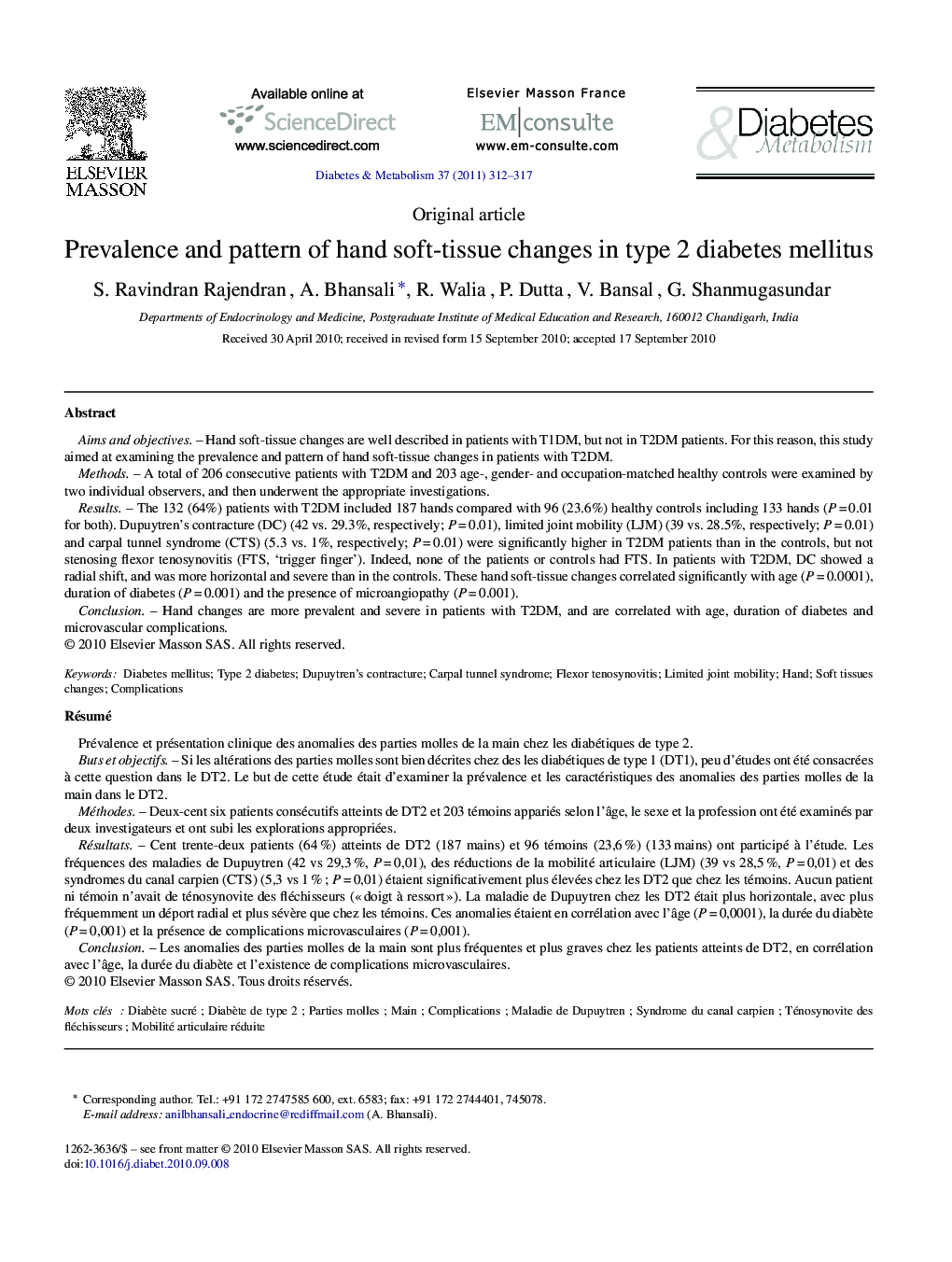| کد مقاله | کد نشریه | سال انتشار | مقاله انگلیسی | نسخه تمام متن |
|---|---|---|---|---|
| 3260298 | 1207610 | 2011 | 6 صفحه PDF | دانلود رایگان |

Aims and objectivesHand soft-tissue changes are well described in patients with T1DM, but not in T2DM patients. For this reason, this study aimed at examining the prevalence and pattern of hand soft-tissue changes in patients with T2DM.MethodsA total of 206 consecutive patients with T2DM and 203 age-, gender- and occupation-matched healthy controls were examined by two individual observers, and then underwent the appropriate investigations.ResultsThe 132 (64%) patients with T2DM included 187 hands compared with 96 (23.6%) healthy controls including 133 hands (P = 0.01 for both). Dupuytren's contracture (DC) (42 vs. 29.3%, respectively; P = 0.01), limited joint mobility (LJM) (39 vs. 28.5%, respectively; P = 0.01) and carpal tunnel syndrome (CTS) (5.3 vs. 1%, respectively; P = 0.01) were significantly higher in T2DM patients than in the controls, but not stenosing flexor tenosynovitis (FTS, ‘trigger finger’). Indeed, none of the patients or controls had FTS. In patients with T2DM, DC showed a radial shift, and was more horizontal and severe than in the controls. These hand soft-tissue changes correlated significantly with age (P = 0.0001), duration of diabetes (P = 0.001) and the presence of microangiopathy (P = 0.001).ConclusionHand changes are more prevalent and severe in patients with T2DM, and are correlated with age, duration of diabetes and microvascular complications.
RésuméButs et objectifsSi les altérations des parties molles sont bien décrites chez des les diabétiques de type 1 (DT1), peu d’études ont été consacrées à cette question dans le DT2. Le but de cette étude était d’examiner la prévalence et les caractéristiques des anomalies des parties molles de la main dans le DT2.MéthodesDeux-cent six patients consécutifs atteints de DT2 et 203 témoins appariés selon l’âge, le sexe et la profession ont été examinés par deux investigateurs et ont subi les explorations appropriées.RésultatsCent trente-deux patients (64 %) atteints de DT2 (187 mains) et 96 témoins (23,6 %) (133 mains) ont participé à l’étude. Les fréquences des maladies de Dupuytren (42 vs 29,3 %, P = 0,01), des réductions de la mobilité articulaire (LJM) (39 vs 28,5 %, P = 0,01) et des syndromes du canal carpien (CTS) (5,3 vs 1 % ; P = 0,01) étaient significativement plus élevées chez les DT2 que chez les témoins. Aucun patient ni témoin n’avait de ténosynovite des fléchisseurs (« doigt à ressort »). La maladie de Dupuytren chez les DT2 était plus horizontale, avec plus fréquemment un déport radial et plus sévère que chez les témoins. Ces anomalies étaient en corrélation avec l’âge (P = 0,0001), la durée du diabète (P = 0,001) et la présence de complications microvasculaires (P = 0,001).ConclusionLes anomalies des parties molles de la main sont plus fréquentes et plus graves chez les patients atteints de DT2, en corrélation avec l’âge, la durée du diabète et l’existence de complications microvasculaires.
Journal: Diabetes & Metabolism - Volume 37, Issue 4, September 2011, Pages 312–317